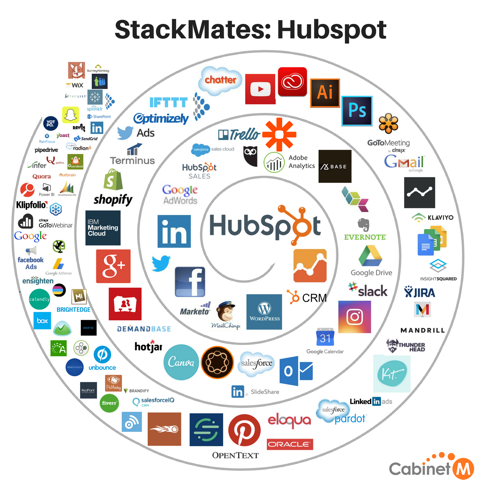The first in a series of contributions from our friends at CabinetM.
When you have a large, brand-name marketing automation platform, do you need to use anything else?
For the enterprises building marketing technology stacks on CabinetM, the answer is indeed yes.
CabinetM helps modern marketing teams build, manage and optimize their marketing technology suite in today’s rapidly transforming digital marketing environment. Enterprises building marketing tech stacks on the CabinetM platform can use those stacks to show what products they use, their costs, with what platforms they integrate, and who in their company is that product’s “owner.”
As stacks are built and managed on CabinetM we are able to derive valuable insights from the aggregated data.
Looking at the stack data for larger marketing technology platforms — Eloqua, HubSpot, Marketo and Pardot – you can see a few trends, and how the platforms differ.
The Platforms
We looked at StackInsight data from the four leading “marketing automation” platforms. Each has multiple features to be deployed on an enterprise scale, including customer communications, personalization, analytics and customer data tools. Each has many features of the other platforms, with a different take on marketing enterprise-wide.
- HubSpot was built to support smaller teams
- Pardot, a product in the portfolio of the CRM giant Salesforce
- Marketo is designed for mid- to large-sized organizations
- Eloqua, an Oracle product for large enterprise environments
It was believed at one time that these enterprise-scale platforms were going to wipe out or absorb the smaller marketing tools for email, sales enablement and other functions. But in reality, they are more likely to be an anchor platform within a large mix of marketing tools that companies use. Our stack data shows that it is also not unusual to find an enterprise using HubSpot AND Salesforce, or Eloqua AND Marketo.
Just as large planets attract other celestial bodies, large-scale marketing technology platforms attract other, smaller tools, creating their own ecosystems.
What’s in a Stack With Marketing Automation Platforms?
Our StackMates graphics show the marketing automation platform at the center with all the other platforms and tools that are their StackMates. The larger the logo and the closer it is to the center of the diagram, the more frequently it appears in stacks. The farther out the less frequently those tools show up.
What generalizations can we make with this data?
- No marketing automation platform is an island; In fact, you can pair marketing automation platforms with each other. Looking at HubSpot for example, the fifth-most popular product used is Marketo.
- Social Media platforms are consistently a large part of most enterprise stacks.
- All marketing automation platforms come with their own analytics, but Google Analytics is one of the most popular tools to pair with other marketing analytics platforms.
Remember, no stack is the same — just because a product isn’t used as often as others in enterprise stacks, do not presume that speaks to that tool’s value.
What’s in your stack? Have questions about the ways you build your technology stack? CabinetM can help: Contact Erica Ross at [email protected].








